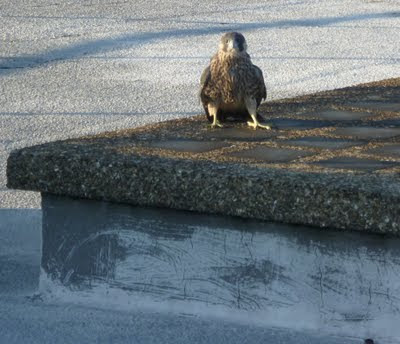On Saturday I visited Parliament rather later than usual , around 6.30am, this was due to staking out another site at dawn which I knew held a territorial Tiercel. The weather at the other site was atrocious, heavy rain but good enough visibility to see that the male had got himself a mate, these days it is only a matter of time.
Yet another pairing, this one is outside London quite away, the structure they are on is far from ideal, but it is there core structure and the male has been there over 8 months, they will not move territory It will be impossible to keep this site unpublicized due to its location, and it also offers up a load of questions.
1. Allthough unsuitable, they will try and breed naturally obviously, probably next year, do you let them try and make a scrape on a surface ( flat concrete) knowing that the eggs may well roll. This could possibly happen year after year.
2. There are about 3 highish buildings around it, all unsuitable due to various reasons, do you risk letting them try and breed on one of these knowing that there will be licencing issues regarding roof space. This will only be if they cannot find anywhere to lay on the core structure. In this case, would it not be better to contain them to the core structure, however unsuitable.
3. Do you place a nestbox on the core structure that they are holding to, knowing that it is not ideal, especially for juveniles, but will give them a far greater chance of success. This site is going to be one of those, if successful, where the juveniles at fledging, will have to be monitored from dawn to dusk. The public will have to be involved.
4. Do you publicise a site knowing that it may put the birds at risk from a minority, the threat is minimal in London at the moment .On the other hand more eyes watching from the public can only benefit the birds.
Certainly food for thought, anyway back to Parliament.
As I arrived the first bird seen was a Tiercel, they or he was back! No sooner than he showed, he was quickly followed by the Falcon, I thought if they are both here, surely the juveniles.
 |
| Falcon - Middle Tower ( photos are poor due to typical crap english weather) |
Both adults flew a few circuits around Victoria Tower and then landed. As they did I heard the unmistakable call of a juvenile, I quickly located him, it was the strong flying male, but despite getting raised hopes that the other 2 were here also, none materialized .
 |
| Juvenile male |
 |
| Victoria Tower |
I suspect that the adults have tried to lead them all over but only the juvenile male has followed. He was always stronger and fledged first, I suspect the other juveniles may not have the wing strength and confidence to make the 1 mile+ flight as yet.
As I write this, who knows, it is only a matter of time, they could already be there, will visit at dawn on Saturday, fingers crossed for good weather and a family of Peregrines.



































